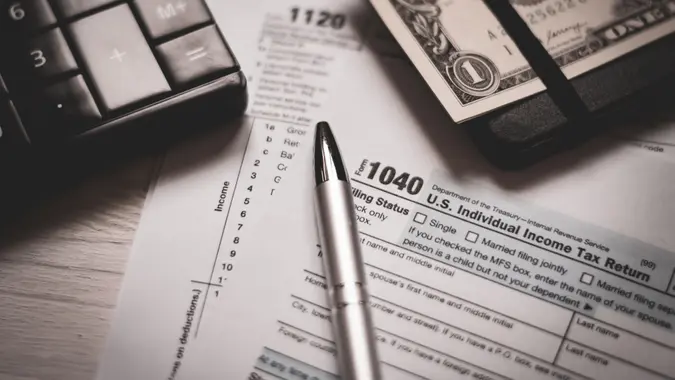Taxes 2024: The 4 Most Overlooked Breaks for Taxpayers Older Than 50

Commitment to Our Readers
GOBankingRates' editorial team is committed to bringing you unbiased reviews and information. We use data-driven methodologies to evaluate financial products and services - our reviews and ratings are not influenced by advertisers. You can read more about our editorial guidelines and our products and services review methodology.

20 Years
Helping You Live Richer

Reviewed
by Experts

Trusted by
Millions of Readers
Taxes are a part of life no matter what age you are. However, if you’re 50 or older, there are a number of tax breaks available to you which could make your life a little easier.
Here are four of the smartest ways to take advantage of tax breaks if you’re age 50 or older, according to the AARP.
1. Take Advantage of a Larger Standard Deduction at 65
For tax year 2023, you’re eligible for a standard deduction of $27,700 if you’re married and filing jointly. You’re eligible for a standard deduction of $13,850 if you’re a single taxpayer, or married and filing separately.
However, if you are 65 or older and file as a single taxpayer, you get an extra $1,850 standard deduction for tax year 2023. If you’re married and filing jointly, the extra standard deduction is $1,500 for each person who qualifies. For taxpayers who are both 65 or older and blind, you get an extra standard deduction of $3,700 as a single taxpayer. If you are married, filing jointly or separately, it’s $3,000 for each person who qualifies.
2. Waiting Longer To Take RMDs With No Penalty
Required minimum distributions (RMDs) are the minimum amounts you must withdraw from a tax-deferred retirement plan, such as a traditional IRA, once you reach a certain age. It’s worth noting that Roth IRAs don’t require distributions while the owner is alive.
Thanks to new 2023 rules under the Secure Act 2.0, you can now wait until the year in which you reach age 73 before you start taking RMDs, up from age 72. If you choose to donate your RMDs, you can donate it to a charity of your choosing (up to $100,000) and you won’t owe any income tax on the distribution.
3. Contribute More Money To Your Retirement Plan
For tax year 2024, the contribution limit for employees who participate in 401(k) and 403(b) programs, the majority of 457 retirement saving plans and the federal government’s Thrift Savings Plan has been increased to $23,000, up from $22,500 in 2023. The good news? Employees 50 and older can contribute an additional $7,500, the same as for 2023, for a total of $30,500.
At the same time, the contribution limit for a traditional or Roth IRA for tax year 2024 is $7,000, up from $6,500 for tax year 2023. Those 50 and older can contribute an additional catch-up amount of $1,000, the same as 2023. The 2024 catch-up contribution limit for a Savings Incentive Match Plan for Employees (SIMPLE) plan is $3,500, the same as 2023.
4. Contribute The Maximum To Your HSA
For tax year 2024, you can contribute up to $4,150 to your health savings account (HSA) if you have coverage for yourself, or up to $8,300 for family coverage. Fortunately, there’s an additional $1,000 catchup if you reach 55 during the year. At the same time, it’s important to note that your contribution limit will be reduced by any amount your employer may have contributed to your HSA that has been excluded from your regular income.
 Written by
Written by  Edited by
Edited by 

























